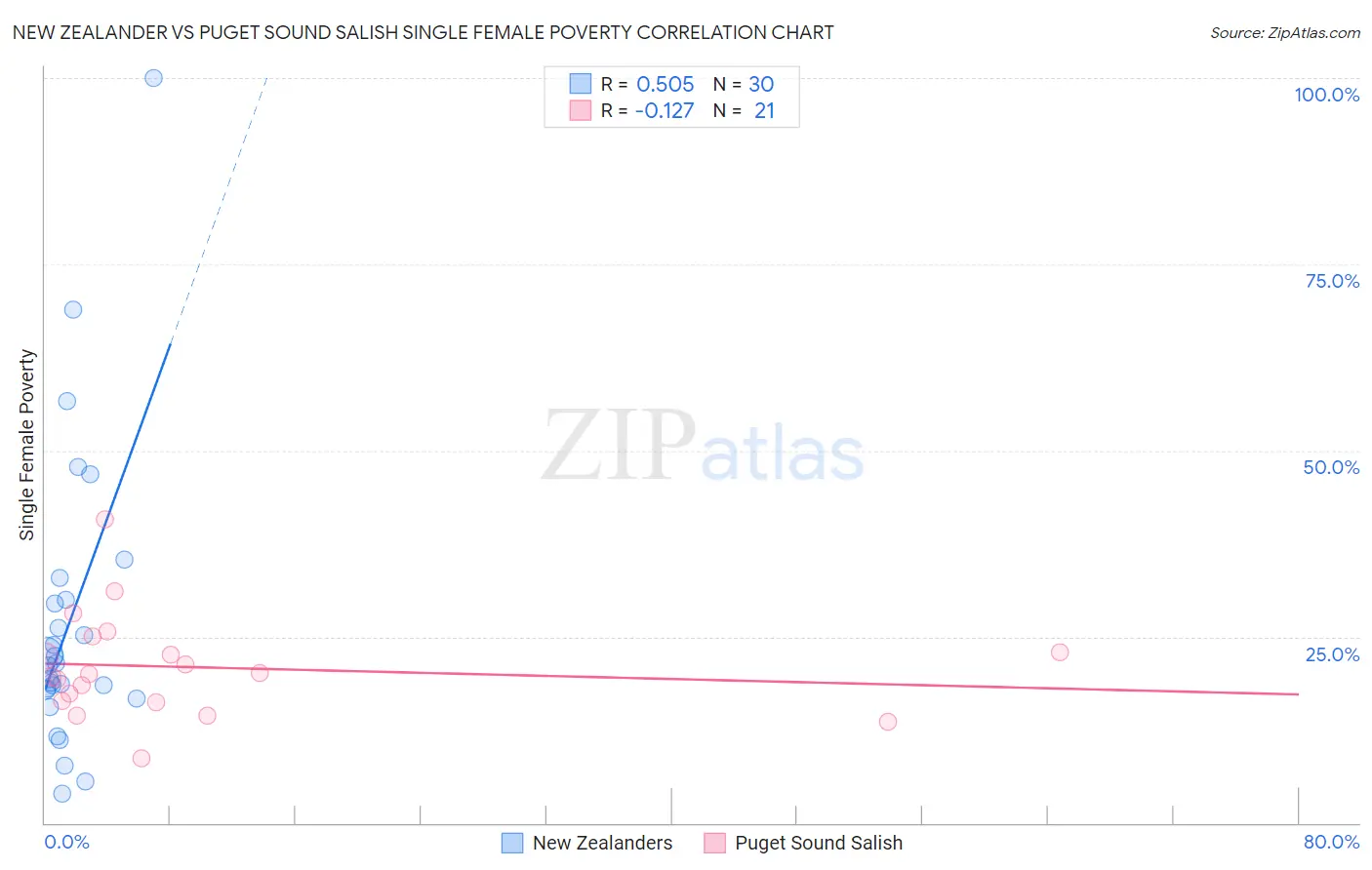New Zealander vs Puget Sound Salish Single Female Poverty
COMPARE
New Zealander
Puget Sound Salish
Single Female Poverty
Single Female Poverty Comparison
New Zealanders
Puget Sound Salish
21.0%
SINGLE FEMALE POVERTY
53.2/ 100
METRIC RATING
170th/ 347
METRIC RANK
20.6%
SINGLE FEMALE POVERTY
79.6/ 100
METRIC RATING
151st/ 347
METRIC RANK
New Zealander vs Puget Sound Salish Single Female Poverty Correlation Chart
The statistical analysis conducted on geographies consisting of 106,229,490 people shows a substantial positive correlation between the proportion of New Zealanders and poverty level among single females in the United States with a correlation coefficient (R) of 0.505 and weighted average of 21.0%. Similarly, the statistical analysis conducted on geographies consisting of 45,841,624 people shows a poor negative correlation between the proportion of Puget Sound Salish and poverty level among single females in the United States with a correlation coefficient (R) of -0.127 and weighted average of 20.6%, a difference of 2.0%.

Single Female Poverty Correlation Summary
| Measurement | New Zealander | Puget Sound Salish |
| Minimum | 3.9% | 8.6% |
| Maximum | 100.0% | 40.8% |
| Range | 96.1% | 32.2% |
| Mean | 27.1% | 20.9% |
| Median | 21.3% | 20.0% |
| Interquartile 25% (IQ1) | 17.8% | 16.4% |
| Interquartile 75% (IQ3) | 29.9% | 24.0% |
| Interquartile Range (IQR) | 12.0% | 7.6% |
| Standard Deviation (Sample) | 20.0% | 6.9% |
| Standard Deviation (Population) | 19.7% | 6.8% |
Demographics Similar to New Zealanders and Puget Sound Salish by Single Female Poverty
In terms of single female poverty, the demographic groups most similar to New Zealanders are Immigrants from Trinidad and Tobago (20.9%, a difference of 0.20%), Immigrants from Costa Rica (20.9%, a difference of 0.54%), Immigrants from Norway (20.8%, a difference of 0.63%), Norwegian (20.8%, a difference of 0.64%), and Ugandan (20.8%, a difference of 0.70%). Similarly, the demographic groups most similar to Puget Sound Salish are Immigrants from Denmark (20.5%, a difference of 0.090%), Immigrants from Uruguay (20.6%, a difference of 0.19%), Swedish (20.6%, a difference of 0.24%), Immigrants from Western Europe (20.6%, a difference of 0.27%), and Samoan (20.6%, a difference of 0.33%).
| Demographics | Rating | Rank | Single Female Poverty |
| Immigrants | Denmark | 80.5 /100 | #150 | Excellent 20.5% |
| Puget Sound Salish | 79.6 /100 | #151 | Good 20.6% |
| Immigrants | Uruguay | 77.7 /100 | #152 | Good 20.6% |
| Swedes | 77.1 /100 | #153 | Good 20.6% |
| Immigrants | Western Europe | 76.7 /100 | #154 | Good 20.6% |
| Samoans | 76.0 /100 | #155 | Good 20.6% |
| South American Indians | 75.7 /100 | #156 | Good 20.6% |
| Immigrants | Oceania | 74.3 /100 | #157 | Good 20.7% |
| Danes | 73.0 /100 | #158 | Good 20.7% |
| Costa Ricans | 71.8 /100 | #159 | Good 20.7% |
| Arabs | 70.8 /100 | #160 | Good 20.7% |
| Kenyans | 68.5 /100 | #161 | Good 20.8% |
| Northern Europeans | 68.4 /100 | #162 | Good 20.8% |
| Lebanese | 67.6 /100 | #163 | Good 20.8% |
| Iraqis | 64.5 /100 | #164 | Good 20.8% |
| Ugandans | 64.0 /100 | #165 | Good 20.8% |
| Norwegians | 63.0 /100 | #166 | Good 20.8% |
| Immigrants | Norway | 63.0 /100 | #167 | Good 20.8% |
| Immigrants | Costa Rica | 61.5 /100 | #168 | Good 20.9% |
| Immigrants | Trinidad and Tobago | 56.3 /100 | #169 | Average 20.9% |
| New Zealanders | 53.2 /100 | #170 | Average 21.0% |